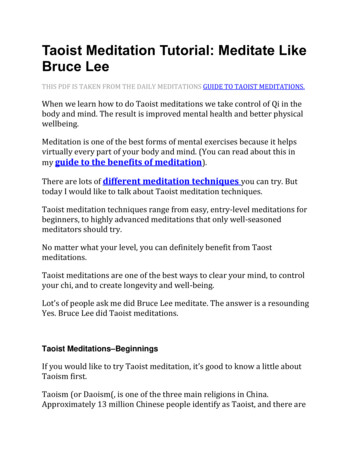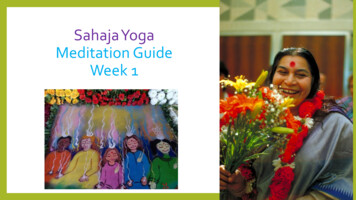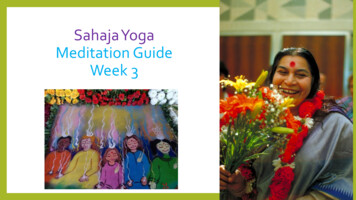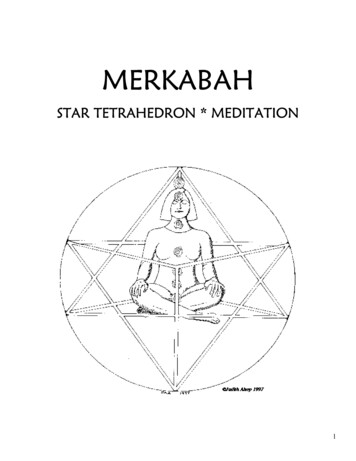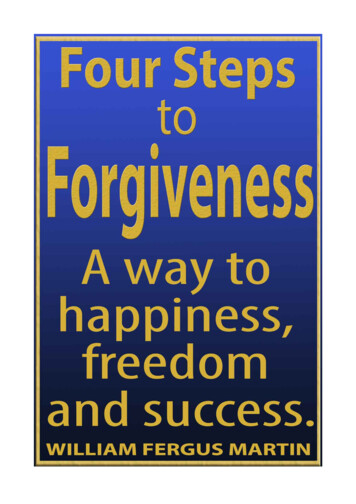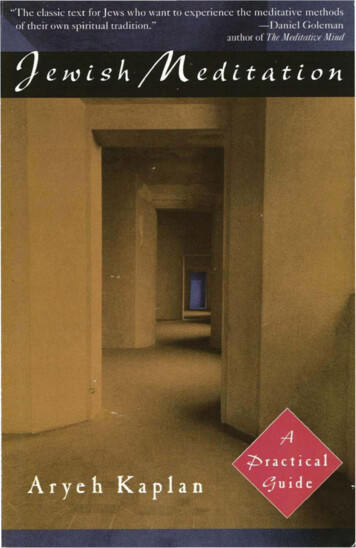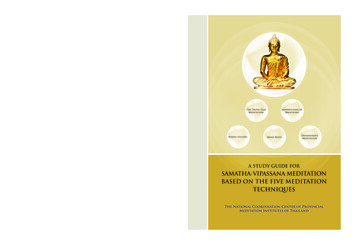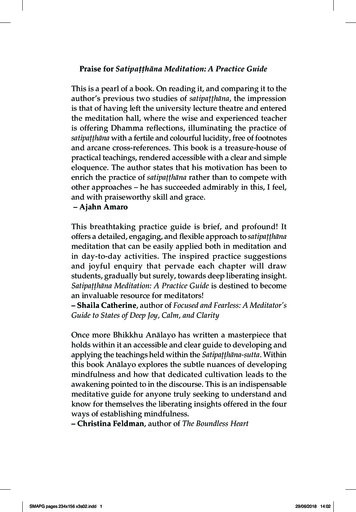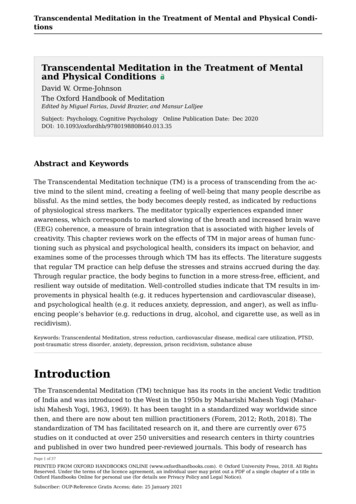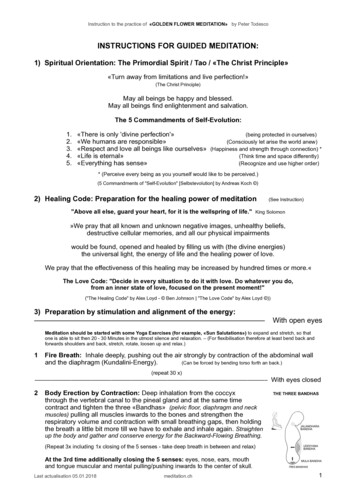
Transcription
Guide to ForgivenessMeditationAn Effective Method to Dissolve Blocks toLoving-Kindness and Living in the PresentBhante Vimalaramsi
Copyright 2015-17 Bhante Vimalaramsi.All rights reserved.Nov. 2020 Major UpdateOther Books by Bhante Vimalaramsi:A Guide to Tranquil Wisdom Insight Meditation 2016Meditation is Life, Life is Meditation2014The Dhamma Leaf Series2014Moving Dhamma Vol 1.2012Breath of Love2011Anapanasati Sutta1998-2003
“There is no question that ForgivenessMeditation is part of Loving-KindnessMeditation development.It is the first step towards Peace.”
Table of ContentsForeword . 8Introduction .10CHAPTER ONE - Preparation .12CHAPTER TWO - Instructions .15CHAPTER THREE - Attachments .19CHAPTER FOUR – Daily Practice .23CHAPTER FIVE - Finding Balance .25CHAPTER SIX - Persistence .27CHAPTER SEVEN - Going Deeper .29CHAPTER EIGHT - Letting Go .31CHAPTER NINE – Relief.32CHAPTER TEN - Obstacles .34CHAPTER ELEVEN – Daily Life .37CHAPTER TWELVE - Success! .39CHAPTER THIRTEEN – Not Easy .41CHAPTER FOURTEEN – Forgive it! .43CHAPTER FIFTEEN – No Mantras .45CHAPTER SIXTEEN – Blame Game .47CHAPTER SEVENTEEN – Be Happy! .49APPENDIX 1 - Review of T.W.I.M. .51About the Author .56Other Resources.57Sharing Merit .58
AcknowledgementThis booklet was based on a talk I gave in 2012 at DSMC.It was done with the intention of making a video for theinternet concerning my basic technique of working withForgiveness in meditation. This talk is on our web site.I wish to acknowledge Ven. Sister Khema's hard work intranscribing this talk, for seeing and conceiving a potentialbook, for her primary editing, and offering her ownadditions and advice during final editing. I also wish tothank a dearly departed Dhamma supporter, Dr. OthaWingo for his contributions in helping to improve the clarityof this subject into a format for easier reading. This was agreat contribution for us all. And David for final editing andpublishing in book form.
8Guide to Forgiveness MeditationForewordWhen Ven. Sister Khema requested me to write aforward to this booklet I accepted the invitation withconsiderable pleasure since I esteem being associated withthis literary endeavor of unusual significance and immensepractical relevance.It is common knowledge that a large number of booksand other literary works have been published on the subjectof all aspects of meditative practices leading to ‘LovingKindness Meditation’. The less discerning public mightwonder ‘why another booklet on the same subject’. Theauthor perhaps anticipating such hesitation and misgivinghas stated the principal objective of this booklet in veryclear and precise terms. Without being far too exhaustive,highly specialized or too scholarly to be of much practicalhelp to the uninstructed and uninitiated or even to theaverage person seeking basic concise guidance, the authorhas provided us a brief, clear and simple handbook which isa much-felt need. Even a cursory glance of the bookletshould make it clear that this booklet is an entirely freshorchestration of most of the salient issues of ForgivenessMeditation.Often the author’s language is unusually illustrative. Forinstance here is a classic example: “ .we can clear therunway for our Mindfulness of Loving-Kindness to take offby first learning to use Mindfulness of Forgivenessmeditation. This is an extremely powerful cleansingpractice.” (Page 8)
Guide to Forgiveness Meditation9The Buddha’s supreme and timeless proclamation ofliberation of thought and the prioritization of the mind overtwenty-five centuries ago is now universally accepted bymodern day scientists. As humanity advances and withintellectual development, the quest for spiritual solaceenhances this advancement. The author clearly indicatesthe principal and unique feature of the discipline of themind through meditation.This booklet shows in clear and simple terms the waytowards spiritual cleansing and dispelling psychic irritants.A commendable feature of this booklet is that thetreatment is basic but very precise and comprehensive. Ihave no doubt whatsoever that this booklet will help thereaders towards meaningful practice of ‘ForgivenessMeditation’ leading to the successful practice of ‘LovingKindness Meditation’.“Bhavatu Sabba Maṅgalaṃ !”May you have All Good Blessings!Ven. H. Kondañña, AbbotStaten Island Buddhist Vihara
10Guide to Forgiveness MeditationIntroductionThe Buddha was a meditation teacher. He taughtmeditation for 45 years after he became fully awakened.When you study and practice meditation you will not beentirely successful until you master the definitions andinterwoven nature of two words. Meditation andMindfulness. I can give you the definitions but then youmust experience for yourself how these two work together.In the Buddhist teachings, Meditation means,‘observing the movement of mind’s attention moment-tomoment, in order to see clearly how the links DependentOrigination actually work.’ Mindfulness means ‘rememberingto observe ‘How’ mind’s attention moves from one thing toanother. This use of mindfulness actually causes mind tobecome sharper as you go as you experience more subtlestates of mind. It isn’t hard to see why you must developthis precise mindfulness to keep the meditation goingsmoothly.Many people practice Loving-Kindness meditation, but,according to a few people, the power of it doesn’t seem tochange much for them in their daily lives. If it doesn’ttake off quite right in the beginning, we might run intodifficulty with this practice and it can be like hitting a wall.It’s good to know that there is a key to the solution fordeveloping metta in our daily activities. That solution islearning to smile as much as you can remember.
Guide to Forgiveness Meditation11Apparently, in some cases, if we do get into trouble, wecan clear the runway for our Mindfulness of LovingKindness to take off by first learning to use Mindfulness ofForgiveness meditation. This is an extremely powerful andcleansing practice. Forgiveness is a form of loving-kindnessthat really clears our mind of negative or unwholesomestates.The reason this book came into being is because of themany questions teachers are asked about ‘why doesn’t myMettā arise easily?’. It is because we need to forgiveourselves first before we can send out pure love to others.
12Guide to Forgiveness MeditationCHAPTER ONE - PreparationAt times, there can be confusion about how toeffectively practice this Mindfulness of Forgivenessmeditation. So, this booklet is dedicated only to thismeditation on forgiveness so you can begin the practicewith a clear goal and better understanding.When people are practicing Loving-Kindness Meditation,you might run into a barrier as you try to send out LovingKindness to yourself and to others. If this happens after afew days, and you are not successful in feeling the metta inthe retreat, it may be suggested for you to take a stepback and start doing the Forgiveness Meditation toovercome these blocks. After all, we cannot sincerely sendLoving-kindness and Forgiveness to someone else when wedo not have it for ourselves. This practice is not just usedfor a person pursuing Loving-Kindness and Compassionmeditation. Any person can make the commitment to cleanhouse by doing this forgiveness work. After this is donefor the first time, one feels many years younger, becauseoften times, a great weight has been lifted off your heartand mind.Some people have the idea that this meditation is acompletely different kind of meditation from the Loving-
Guide to Forgiveness Meditation13Kindness meditation. That is not so. It should be madeclear from the beginning that the Forgiveness Meditation isnot outside of the development of Loving-Kindness and is apart of metta. For anyone who has difficulty in feelingloving-kindness, this can be the first step. It creates afirm bridge between heart and mind that is then used tohelp all other kinds of meditation succeed. It is a cleansingfor the heart: another opening of the heart we can add toour initial practice of Generosity.In truth, this meditation is probably the most powerfulmeditation that I know. It can clear away mental blocksthat pop up from old attachments or dislikes towardsvarious people, or events that happened to you in your pastlife experiences. If you follow directions closely, and youare patient when you practice, then pain and suffering willgradually dissolve any hard-heartedness you still carry inyour mind, about past life wounds.When you practice Forgiveness meditation, all of thebasic rules will remain the same. You still sit in a reasonablyquiet space to do this work. Be sure you are wearing loosecomfortable clothing. Sit in a comfortable position, on thefloor or in a chair. If you do use a chair, don’t lean into theback of the chair. Sit with your spine nicely straight butnot tightly erect. Sit in a position that does not bring upphysical pain in general for you. You should follow thebasics of practicing Right Effort using Tranquil WisdomInsight Meditation (TWIM) and the 6Rs for yourmeditation cycle to accomplish your goal.
14Guide to Forgiveness MeditationWhen you practice, sit for a minimum of 30 minuteseach time. Sit longer if things are going smoothly and youhave the time. At whatever time you decide to break yoursitting, stand up slowly. Keep your observation going as youstand up. Stretch slowly if desired.While you are sitting, do not move at all. Don’t wiggleyour toes, don’t scratch. If your body needs to cough orsneeze, do not hold this in; just sneeze or cough! Keep sometissues close by for any tears that might arise. If tears dofall, then let them come. That is what you have holes in youreyelids for So, let the tears come out. This releases thepressure. Consider this the cleansing time before you takeup any other primary meditations.While practicing Forgiveness meditation, please useONLY these meditation instructions and put all othermeditation instructions aside until you have completed thework. This just means that we don’t want to confuse mind,so, don’t mix up the recipe! We want only the informationneeded to do this practice.
Guide to Forgiveness Meditation15CHAPTER TWO - InstructionsThe way you start practicing forgiveness meditation isby forgiving yourself.There are different kinds of statements that you canuse for this to help bring up any old grudges and hardheartedness locked inside you. You may pick one statementto begin, and then you stay with that statement for aperiod of time, to give it a chance to settle in and you andsee what comes up. The first suggested phrase is “Iforgive myself for not understanding.” Everybody hasmisunderstandings that happen in their life. Nobody isexempt from this fact.While you are sitting in meditation, you repeat thephrase, “I forgive myself for not understanding.” Afteryou’ve done that, you put that feeling and wish, into yourheart and stay with that sense of forgiveness. When thatfeeling fades away, or the mind gets distracted, then youcome back and forgive yourself for ‘not understanding’ yetagain. Repeat the phrase to yourself.This is a methodology. The way it works is below Silently say the phrase to yourself: I forgivemyself for not understanding.” Let it be an openstatement or intention.
16Guide to Forgiveness Meditation Continue with this phrase. As the feeling or thewish of Forgiveness fades then say the phraseagain. When a disturbing thought comes up about a pastincident or person then Forgive that person orperson – or yourself- and then Relax anytightness that is left. There will be a painfulfeeling that arises and your mind won’t like it!This where the Relax step is so important. If wereact to the pain then this keeps the cycle going.You are feeding it through your aversion whenyou bring up this painful incident. You don’t likeand even hate this feeling. This leads to beatingyourself up and not accepting that this is only amemory and it is long gone. Accept whatever comes up and forgive and thenrelax Forgive, Relax - this is what you do each time If it is just a distraction or a wandering mindthen Forgive that too! Forgive anything thattakes you away from forgiving yourself. Then return to your phrase yet again “I forgivemyself for not understanding ” Do this cycle over and over. You forgive yourselffirst; you are the object of the meditation. Thenwhile you are forgiving yourself you forgiveanything that distracts you from wishing yourselfforgiveness. Gradually disturbances fade away and you areleft with yourself – finally in the Present! Reliefarises in the mind by throwing off these painful
Guide to Forgiveness Meditation17memories and letting go of the reactive mindthat arises right after.For those familiar with the Jhānas, and have meditatedbefore, it is necessary to not go higher than the first jhāna.You can’t mentally verbalize beyond that (say your phrasesfor forgiveness). Please make a determination to not go anydeeper. This is an active contemplative process that we aredoing now.While you’re doing this, your mind is going to have someresistance to this meditation. Your mind is going to takeoff and say, “Well, this is stupid! I shouldn’t be doing this!Reactions like these are part of your attachments. Theseare the obstacles that we must dissolve.Stay with your statement and repeat, “I forgive myselffor not understanding.” Then your mind might say, “AAH! Idon’t need to do this anymore. This meditation doesn’twork”. Every thought that pulls you away from forgivingyourself for not understanding is an attachment and has tobe let go, and the tension and tightness in that attachmentmust be “relaxed” away.This is where you will use your forgiveness. Anydistractions or any sort of disturbances must be forgiven.To forgive we notice we have been distracted away fromour object of meditation -or what we are doing in thepresent moment. We then Forgive the distraction and thenRelax. Relax that tension and tightness that arises fromthe distraction or disturbance.It doesn’t matter how many times your mind getsdistracted. One thing that many people get caught with isgetting wrapped up in the story about things, and this cancause lots of pain and suffering along with some frustration.Forgiveness will help you with strong the attachments and it
18Guide to Forgiveness Meditationshows the way to overcome the suffering they cause.Recognize it. Let it be. Relax. Smile. Come back and staywith the feeling of forgiveness for as long as you can.Sitting should be followed by Walking Practice. If youare going to continue sitting again, or you are going toreturn to a task in daily life, before you do, take a stroll, ata normal pace to keep your blood flowing nicely. Walk forabout 15 minutes minimum in some fresh air. 45 minutes isa good maximum time for walking. If you are working in arestricted space setting, find a space that is level and atleast 30 feet long in length. Walk back and forth, andmentally, keep your meditation going.*When you walk you want to walk in a way that yourepeat the phrases with each stride as you walk. Like this with the left foot take a step and mentally say “I” then aright step “forgive” and left “you.” Then again, but say,“You” on the right step, and then left step, “forgive,” rightstep, “me.” And repeat. Back and forth. You can experimentand see what works. It can get into a nice cadence but allthe while it is really getting it into your ‘noggin’ to forgive!“I forgive you, you forgive me.” And keep smiling whenyou are doing this. And Forgive anything or anyone whocomes up that takes you away. Stay with the walking. Iused to go for 6-8 mile walks in Hawaii doing just thispractice!The idea of sitting and walking is to create a continuousflow of meditation without stopping. This proves you cankeep the meditation with you all the time in life. Whilewalking at this normal pace, continue doing the forgivenessmeditation with your eyes looking down towards the groundabout 6 or 7 feet in front of you. Do not look around. Keepon gently forgiving. Keep smiling all the time.
Guide to Forgiveness Meditation19CHAPTER THREE - AttachmentsOne mistake that an awful lot of people make is they say,“Well, meditation is just for sitting. The rest of the time Idon’t have anything else to do, so, I can let my mind act likeit always does.” This is a mistake. We need to consider theidea that Meditation is life and Life is meditation. You wantto realize that you have attachments in your daily life andjust because you are not sitting doesn’t mean thoseattachments aren’t there. The whole point in doing themeditation is for personality development. It’s for lettinggo of old habitual suffering [bhava}, and in place of this,developing a mind that has equanimity in it.The more resistance your mind has in doing this, themore you need to do it, because the resistance is your mindshowing you where your attachment is, and that is the causeof suffering. This meditation works better than anythingthat I know of for letting go of attachments, letting go andrelaxing of old hard-hearted feelings [bhava], letting go ofthe way you think the world is supposed to be, so you canstart accepting the way the world actually is.Your mind might say, “Well, I don’t like that! I don’t likethe way they said this or that.” Ask yourself now, “Whodoesn’t like it? Who is judging and condemning? Who is
20Guide to Forgiveness Meditationmaking up a story? Who is caught by their attachment?”“Well, ‘I’ am!”It might be helpful here to give a definition ofattachment. An attachment is anything we take personally,any thought, any feeling, any sensation! When we thinkthese thoughts or feelings are “mine”, this is “me”, this iswho “I” am, at that point, mind has become attached andthis causes craving to arise in your mind and body.Craving always manifests as a tension or tightness inboth mind and body. Craving is the “I” like it, “I” don’t likeit mind - which arises in everyone’s mind/body process.Attachment is another word for craving and is the start ofall suffering. When we see that everything that arises ispart of an impersonal process, then, we begin to understandwhat it is like to see things with a clear observant mind.Somebody might say something very innocently and youhear it through your attachment and it’s negative. This iswhy we have to learn how to become aware of what ishappening all the time in our daily lives.When you get finished sitting in your meditation for 30minutes, 45 minutes, or for an hour and you start walkingaround, what does your mind do? It takes off just like italways does. It thinks about this. It thinks about that.This is just non-sense thoughts.Most of us think those thoughts and those feelings thatarise are ours personally; that they are not just randomthings. But, in truth, if you feed any kind of a thought orfeeling with your attention, you make it bigger and more
Guide to Forgiveness Meditation21intense. When you realize that you are causing your ownsuffering, you have to forgive yourself for doing that.This means saying, “I forgive myself for notunderstanding. I forgive myself completely.” Of course,your mind is going to take off again and say,”Aah! This isstupid! This is nothing. This isn’t real. This isn’t what isactually happening. ‘I’ don’t want to do this!”Every one of those thoughts is an attachment, isn’t it?Every one of those thoughts has craving in it, doesn’t it?Every one of those thoughts is causing you suffering, right?Because of this, you have to recognize that you aredoing this to yourself and let go of those thoughts. That’sjust nonsense stuff anyway. It doesn’t have anything to dowith what you are doing and where you are right now. Onceyou know this, you forgive yourself for not understanding;for causing yourself pain; for causing other people pain.YOU REALLY FORGIVE.Take a look at when you are walking from here to there.What are you doing with your mind? “Ho Hum. Thinkingabout this, and, I gotta do that, and, I have to go talk tothat person, and, I have to do this.” All of that’s non-sense!Now, this doesn’t mean that you can’t plan what you needto do next. You can. But just do that planning one time asyour primary topic in the present moment. After you makeup your mind what the plan is, you don’t have to think aboutit anymore. Repeating it, rolling it around again; all of thatis just part of your old habitual tendency (bhava in Pāli). It
22Guide to Forgiveness Meditationis your old conditioned thoughts and feelings, and takingthem personally and causing yourself pain and suffering.
Guide to Forgiveness Meditation23CHAPTER FOUR – Daily PracticeIncluding the exercise of forgiveness in your dailyactivity is by far the most important part of thismeditation. You forgive yourself continually, for notunderstanding, for getting caught up in this or that, fortaking things personally. How many times have you foundyourself doing this? “Hey! I don’t like the way you saidthat.” Ask yourself. WHO doesn’t like what? “Well, yousaid something that was hurtful.” To WHOM?You need to stop and realize that you’re taking all thisstuff personally and it’s not really personal. It’s just stuffthat happens. Forgive it! Forgive it even when you’rewalking along a road and you happen to kick a rock and ithurts. Forgive the pain for being there! Your job is to keepyour mind forgiving all the time. That’s what Mindfulness ofForgiveness Meditation practice is all about. The techniqueis not just about when you are sitting. This is a life practice.This is an all-the-time practice.If you want to really begin to change, you have to bewilling to go through the forgiveness sincerely, because itwill help you change a lot. You have to have patience and ithelps to have a sense of humor about just how dumb mind
24Guide to Forgiveness Meditationcan be. The more you smile and laugh the easier themeditation becomes.
Guide to Forgiveness Meditation25CHAPTER FIVE - Finding BalanceWhenever you personally continue to think about thisand that, to judge this and condemn that, you areconstantly causing yourself suffering. You don’t need to dothat. You want to argue with other people about yourattachments? What’s the point? When you really startpracticing forgiveness for yourself, or forgiveness foranother person, your mind starts to get into balance andyour sense of humor begins to change. This is equanimity.Then you don’t take thoughts, feelings and sensations andall this other stuff personally.When you practice in this way, you are seeing life forwhat it is and allowing it to be there. It’s not worth goingover it in your mind, and over it, and over it, and over it.It’s not worth it. It’s a waste of time. It’s a waste ofeffort. Every time you have a repeat thought, you areattached. You’re identifying with that thought and you’retaking it personally and that is again the cause of suffering.What you are seeing here is the Second Noble Truth. Youare witnessing how Craving, taking it personally is the causeof suffering. And you can’t blame anybody else for it. It’syours. You are doing it all to yourself. “WELL, they saidthis!”
26Guide to Forgiveness MeditationSo what?Others may have their opinion. That doesn’t mean ‘I’have to listen to them. I don’t have to take it in personallyand analyze whether it’s correct or not, because it doesn’tmatter. The more you forgive in your daily life and dailyactivities, the easier it is to forgive the big things thathappened in the past.
Guide to Forgiveness Meditation27CHAPTER SIX - PersistenceWhen you’re doing the Forgiveness Meditation whileyou’re sitting, you’re staying with one of the suggestedstatements. You stay with that one statement until youinternally feel, “YES, I really do forgive myself for notunderstanding.” It’s important to work this through.To really forgive can take a while. It’s not just somequick fix to do in one sitting and then you come in and say,“OK, now I’m done!”, or you say, “I’ve already done that.”Doing that is not where you’re going to get real change.Nope. You still have your attachments there. You still haveto continually forgive yourself for not understanding,forgive yourself for making a mistake. That is what notunderstanding is about. You have to forgive yourself forjudging, for condemning, for analyzing, for thinking, forgetting angry. Forgive everything, all of the time.When I started to do the forgiveness meditation, which,I did personally for myself for two years, because I wantedto make sure I really understood this meditation, I wentthrough major changes. There were major changes; majorpersonality changes. If you want that for yourself, youhave to have that kind of patience.
28Guide to Forgiveness MeditationThis idea of, “Well, I’ve already forgiven this person orthat person”, that simply isn’t it. A little later on you figureout that you’re talking about how YOU didn’t like this orthat from them! Ah! Guess what? Who hasn’t finishedtheir forgiveness meditation? YOU haven’t forgivenyourself, or that other person!
Guide to Forgiveness Meditation29CHAPTER SEVEN - Going DeeperWhen you start to go deeper in your meditation, stayingwith the forgiveness, and you do forgive yourself formaking mistakes, there can come a time when somebodycomes up into your mind that you need to forgive.When this happens, you realize that you did not askthem to come up. You do not stop and say, “Well, I needthis person to come up.” They came up by themselves.As soon as that person comes up, you start forgivingthem, for not understanding. It doesn’t matter what theydid in the past. All of your thoughts, all of your opinions ofwhat they did in the past just keep bringing up moresuffering.These thoughts come up because of your attachment. “Ididn’t like that! I didn’t want that to happen! They are adirty no good so and so because they did that to me.” Canyou guess where the attachment is? Guess where the ideacomes from that I can blame somebody else for my ownsuffering? The only person you can blame for yoursuffering is yourself. Why? Because, YOU are the onethat took it personally. You’re the one who had an opinionabout it. You’re the one that used your habitual tendencies
30Guide to Forgiveness Meditationover and over again to justify the idea that I’m right andyou’re wrong. That’s how we cause our own suffering.The forgiveness meditation helps you let go of thatopinion, that idea, that attachment, and feel some relief.Because some past person did or said something that causedanger, resentment, jealousy, pain or whatever the catch ofthe day was – it can have a real tendency for your mind toget caught up in thinking about that past event.This is called getting caught by the story. You need toForgive getting caught by the story and then go back toyour forgiveness statement. It does not matter how manytimes the story arises forgive yet again. The story’semotion will fade away after you do this enough. This iswhere patience is needed.
Guide to Forgiveness Meditation31CHAPTER EIGHT - Letting GoWhen you see someone else come up in your mind,somebody you really had a rough time with and you didn’tlike it; someone you started hating for whatever reason, youforgive them. With your mind’s eye, you look them straightin their eye and you tell them sincerely: “I forgive you fornot understanding the situation, I forgive you for causingme pain, I forgive you completely.”Now, keep that person in your heart and radiateForgiveness to them. If your mind has a distraction and itpulls you away from that; you might hear in your mind, “No,I don’t, that no good so and so. I won’t forgive him!” Let goof this and come back and say, “I do forgive you.”It has to be sincere. “Well, I’m not going to forgive thatdirty no good so and so.” Why not? “Because, they caused‘ME’ suffering!” Oops! WHO caused who suffering? YOUcaused your own self suffering because you took itpersonally, and YOU reinforced that with a lot of thoughtsand opinions and ideas about why that was wrong.In other words, you were caught in your craving, yourown clinging, your habitual tendencies and that leads tomore and more dissatisfaction, aversion, pain and suffering.
32Guide to Forgiveness MeditationCHAPTER NINE – ReliefIt’s really important to realize that this is not an easypractice. It’s hard to forgive someone when they havereally caused you harm. Take a woman that has been rapedor a man who has been beaten and robbed. It’s hard toforgive the person who raped them or beat them becausethey have been violated. But, holding onto their hatred ofthat person is keeping them attached. It doesn’t matterwhat the action was. It doesn’t matter what happened inthe past. What matters is what you are doing with whatyou have in your mind right now.To completely develop this practice to the highest levelmeans that you keep forgiving and forgiving! Over and over.With your mind’s eye, you look them straight in the eye andyou say, “I really do forgive you.” And your mind says, “NO,I DON’T” And you let that go, and come back. You say, “Ireally do forgive you.” Then take that person and put themin your heart and continue to radiate forgiveness to them.How long do you do that? As long as it takes.For some attachments, one or two sittings is all you willneed. Some other attachments, might take a week; mighttake two weeks or even long
12 Guide to Forgiveness Meditation CHAPTER ONE - Preparation At times, there can be confusion about how to effectively practice this Mindfulness of Forgiveness meditation. So, this booklet is dedicated only to this meditation on forgiveness so you can begin

